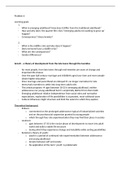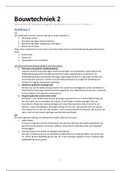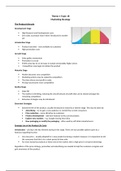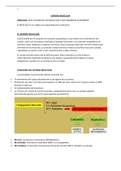Problem 6
Learning goals:
1.
- What is emerging adulthood? How does it differ from the traditional adulthood?
- How and why does ‘the quarter-life crisis’/’emerging adults not wanting to grow up’
happen?
- Consequences? Stress/anxiety?
2.
- What is the midlife crisis and why does it happen?
- Does everyone have a midlife crisis?
- What are the consequences?
- Gender differences?
Arnett – a theory of development from the late teens through the twenties
- for most people, from late teens through mid-twenties are years of change and
important life choices
- Over the past half century marriage and childbirth ages have risen and more people
obtain higher education
- Since marriage and parenthood are delayed it’s no longer normative for late
teens/early twenties to settle into long-term adult roles
- This article proposes ages between 18-25 is emerging adulthood, neither
adolescence nor young adulthood but it’s empirically distinct from them both
- Emerging adulthood: relative independence from social roles and normative
expectations, exploration of life possibilities is at greatest, most volitional years
- Cultural influences might structure and limit the extent to which they explore
Theoretical background
- Erikson:
o commented on the prolonged adolescence typical of industrialized societies
and on the psychosocial suspension granted to young people
o which through free role experimentation they may find their place in society
- Levinson:
o ages between 17-33 is the novice phase of development to move into adult
world and build a stable life structure
o during which they experience change and instability while sorting possibilities
- Keniston’s theory of youth:
o youth is a period of continued role experimentation between adolescence
and young adulthood
o tension between self and society
o his application of the term ‘youth’ is problematic
, Emerging adulthood is distinct demographically
- emerging adulthood is the only period which nothing is demographically normative
- during adolescence: 95% live at home with parents, 98% is unmarried, fewer than
10% have children, and 95% are enrolled in school
- by age 30: 75% is married, 75% have kids, fewer than 10% enrolled in school
- Between these periods, demographic status is difficult to predict only based on age
- unpredictability and diversity of demographics reflects the experimental and
exploratory quality of emerging adulthood
- Frequent residential status changes also reflect the exploratory changes during
emerging adulthood (depending on college, job, moving back to parents etc.), most
of them move out of their parents houses
- School attendance is another area with change and diversity
o About 1/3 of those who graduate with a bachelor’s degree enroll in
postgraduate education the following year
Emerging adulthood is distinct subjectively
- When emerging adults are asked if they’ve reached adulthood they don’t say or no
but say in some respects in an ambiguous way
- They have no name for the period they are in – reflects the subjective sense
- Only around their late twenties and early thirties a clear majority consider
themselves as adults
- Surprisingly, demographic transitions such as finishing education settling into a
career, marriage and parenthood rank at bottom in importance among necessary
criteria for adulthood
- The characteristics that matter are not demographic but individualistic qualities of
character
o Top 3 criteria:
o Accepting responsibility for one’s self
o Making independent decisions
o Being financially independent
o These reflect the emphasis on becoming a self-sufficient person
o These are typically accomplished around late twenties
- Becoming a parent is ranked low but those who have had children mark it as the
most important transition to adulthood
Emerging adulthood is distinct for identity explorations
- Identity exploration is usually associated with adolescence
- But industrialized societies allow extended identity explorations
- Identity achievement is rarely reached by the end of high school and it continues
through late teens and early twenties
- 3 main areas of identity exploration: love, work and worldviews
o In all 3 areas the process begins in adolescence but takes place mainly in
emerging adulthood
o Love: in adolescence dating is recreational, doesn’t last long, but in emerging
adulthood its more about emotional and physical intimacy and lasts longer
o Work: adolescents see jobs not as occupational preparation but a way to
make money, in emerging adulthood work experiences become more focused
Learning goals:
1.
- What is emerging adulthood? How does it differ from the traditional adulthood?
- How and why does ‘the quarter-life crisis’/’emerging adults not wanting to grow up’
happen?
- Consequences? Stress/anxiety?
2.
- What is the midlife crisis and why does it happen?
- Does everyone have a midlife crisis?
- What are the consequences?
- Gender differences?
Arnett – a theory of development from the late teens through the twenties
- for most people, from late teens through mid-twenties are years of change and
important life choices
- Over the past half century marriage and childbirth ages have risen and more people
obtain higher education
- Since marriage and parenthood are delayed it’s no longer normative for late
teens/early twenties to settle into long-term adult roles
- This article proposes ages between 18-25 is emerging adulthood, neither
adolescence nor young adulthood but it’s empirically distinct from them both
- Emerging adulthood: relative independence from social roles and normative
expectations, exploration of life possibilities is at greatest, most volitional years
- Cultural influences might structure and limit the extent to which they explore
Theoretical background
- Erikson:
o commented on the prolonged adolescence typical of industrialized societies
and on the psychosocial suspension granted to young people
o which through free role experimentation they may find their place in society
- Levinson:
o ages between 17-33 is the novice phase of development to move into adult
world and build a stable life structure
o during which they experience change and instability while sorting possibilities
- Keniston’s theory of youth:
o youth is a period of continued role experimentation between adolescence
and young adulthood
o tension between self and society
o his application of the term ‘youth’ is problematic
, Emerging adulthood is distinct demographically
- emerging adulthood is the only period which nothing is demographically normative
- during adolescence: 95% live at home with parents, 98% is unmarried, fewer than
10% have children, and 95% are enrolled in school
- by age 30: 75% is married, 75% have kids, fewer than 10% enrolled in school
- Between these periods, demographic status is difficult to predict only based on age
- unpredictability and diversity of demographics reflects the experimental and
exploratory quality of emerging adulthood
- Frequent residential status changes also reflect the exploratory changes during
emerging adulthood (depending on college, job, moving back to parents etc.), most
of them move out of their parents houses
- School attendance is another area with change and diversity
o About 1/3 of those who graduate with a bachelor’s degree enroll in
postgraduate education the following year
Emerging adulthood is distinct subjectively
- When emerging adults are asked if they’ve reached adulthood they don’t say or no
but say in some respects in an ambiguous way
- They have no name for the period they are in – reflects the subjective sense
- Only around their late twenties and early thirties a clear majority consider
themselves as adults
- Surprisingly, demographic transitions such as finishing education settling into a
career, marriage and parenthood rank at bottom in importance among necessary
criteria for adulthood
- The characteristics that matter are not demographic but individualistic qualities of
character
o Top 3 criteria:
o Accepting responsibility for one’s self
o Making independent decisions
o Being financially independent
o These reflect the emphasis on becoming a self-sufficient person
o These are typically accomplished around late twenties
- Becoming a parent is ranked low but those who have had children mark it as the
most important transition to adulthood
Emerging adulthood is distinct for identity explorations
- Identity exploration is usually associated with adolescence
- But industrialized societies allow extended identity explorations
- Identity achievement is rarely reached by the end of high school and it continues
through late teens and early twenties
- 3 main areas of identity exploration: love, work and worldviews
o In all 3 areas the process begins in adolescence but takes place mainly in
emerging adulthood
o Love: in adolescence dating is recreational, doesn’t last long, but in emerging
adulthood its more about emotional and physical intimacy and lasts longer
o Work: adolescents see jobs not as occupational preparation but a way to
make money, in emerging adulthood work experiences become more focused











